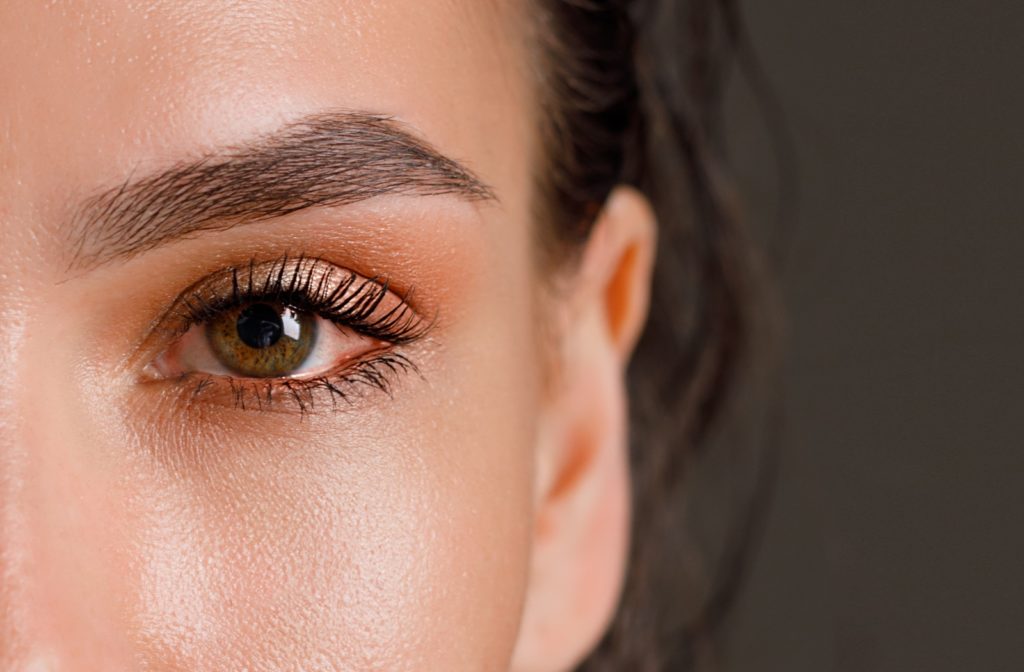What Causes Red Eyes?
Seeing red can be alarming, especially when bloodshot or pinkish eyes are recurring. Eye redness can be a symptom of multiple conditions. Some common causes include:
- Allergies
- Broken blood vessels
- Contact lens wear
- Dry eyes
- Eye infections
- Eye inflammation
- Eye damage or injury
- Photokeratitis (eye sunburn)
- Using alcohol or cannabis
Eye drops, whether over-the-counter or prescribed, can be a convenient option for alleviating red eyes. However, some patients can experience side effects because of preservatives or overuse.
What works best for your eyes can depend on the cause of the redness, such as poorly-fitted contact lenses, dry eyes, or other eye conditions. It’s crucial to book an eye exam to have your eye health assessed.
You may also want to try a few things at home or prepare for a discussion with your eye doctor. When looking for eye drop alternatives, consider these methods for getting rid of red eyes.
Resting Your Eyes
Eye redness can sometimes be the result of tired eyes. Although rest can’t cure redness caused by infection or injury, it can help your eyes heal by giving them a much-needed break. Additionally, closing your eyes shields them from environmental irritants—such as dust, bright light, or dry air.
While you’re taking an eye rest, try adding a warm compress. The mild heat and moisture can help alleviate inflammation and pain. It can also help unclog oil glands, a common cause of dry eye. A warm compress can treat various eye problems, including:
- Conjunctivitis (pink eye)
- Blepharitis
- Eyelid swelling
- Muscle spasms
- Styes or chalazion
Rest shouldn’t be the only treatment you try, but it can alleviate some discomfort. However, if closing your eyes or blinking causes eye pain, contact us for emergency eye care.
Taking Contact Lens Breaks
Contact lenses can be a convenient option for correcting vision. When you wear your lenses every day, you grow accustomed to the feeling. However, as normal as your contact lenses may seem to you, it’s still a foreign object resting on the surface of your eye.
Eyelid hygiene and contact lens care can limit the risks of contact lens wear. Still, there are potential side effects that may be causing irritated, red eyes. Soft contact lenses are particularly susceptible to protein and lipid deposits. These depositions can aggravate eye allergies and dry eye.
You may benefit from a switch when your contact lenses irritate your eyes, causing eye redness or dry eye. Rigid gas permeable contact lenses or silicone hydrogel lenses are better for patients prone to eye redness or dryness. However, scleral lenses are generally considered the most beneficial.
Removing your contact lenses a few times during the day may improve some symptoms, including eye redness. However, if eye redness and discomfort are persistent, talk to your eye doctor about alternative lenses you can try.
Avoiding Irritants
It can sometimes be challenging to predict what may irritate your eyes if you don’t have a known allergy. Irritants may be as simple as dust blowing into your eyes or sensitivity to perfumes or cleaning products. You may start a journal or take notes whenever you notice symptoms and try to pinpoint the cause.
When finding the source of eye irritation proves difficult, your eye doctor may be able to help. After an eye exam and a discussion, our eye doctors can work with you to develop a plan for avoiding and treating irritated eyes. There are also some things you can try at home to protect your eyes, including:
- Wearing sunglasses to protect your eyes from UV light and outdoor irritants
- Wearing protective eyewear (appropriate for your job, hobby, or task)
- Using chemicals as directed & in well-ventilated areas
Also, pay attention if eye discomfort or redness occurs after attaching eyelash extensions. Although the extensions directly contact your skin (when applied correctly), the chemical ingredients in adhesives or removers can also affect eye tissue, causing:
- Bloodshot eyes
- Burning or itchy eyes
- Pain (eye and surrounding area)
- Rash (skin around the eye)
- Inflammation (eye or eyelid)
- Swelling (eye or eyelid)
If symptoms persist over 24 hours, you should book an appointment. Your eye doctor can evaluate if you’re experiencing an allergic reaction, infection, or other eye condition and prescribe the appropriate treatment.
Drinking More Water
Eye drops are a direct option for moisturizing the surface of the eye. But there’s a classic indirect approach to improving your body’s moisture content: drinking water. When your eyes are dry, they can get irritated, feel gritty, or appear red. Adding more moisture allows your eyes to produce more tears to lubricate and nourish your eyes.
Hydration is crucial for our health, as our bodies are more than 50% water. Dehydration can harm our eyes and lead to vision problems. The average adult should drink 6–8 servings (8-ounces per serving) of water each day. However, your unique health and environment can influence that number. For example, drink more water after a workout or in dry climates.
If you’re not a fan of plain water, try other options for consuming more water. For example, you may flavour your water with fruits and herbs or consume healthier drinks. Don’t forget about water-rich foods to make hydration tastier!
Visit Us for More Red Eye Relief
You deserve better than irritated, red, or uncomfortable eyes. Our practice is dedicated to providing our patients with comprehensive care for healthy eyes and vision. So when red eyes are causing discomfort or interrupting your day, contact us. We can discuss a customized treatment plan to improve your comfort. Book an appointment today for red-eye relief.




